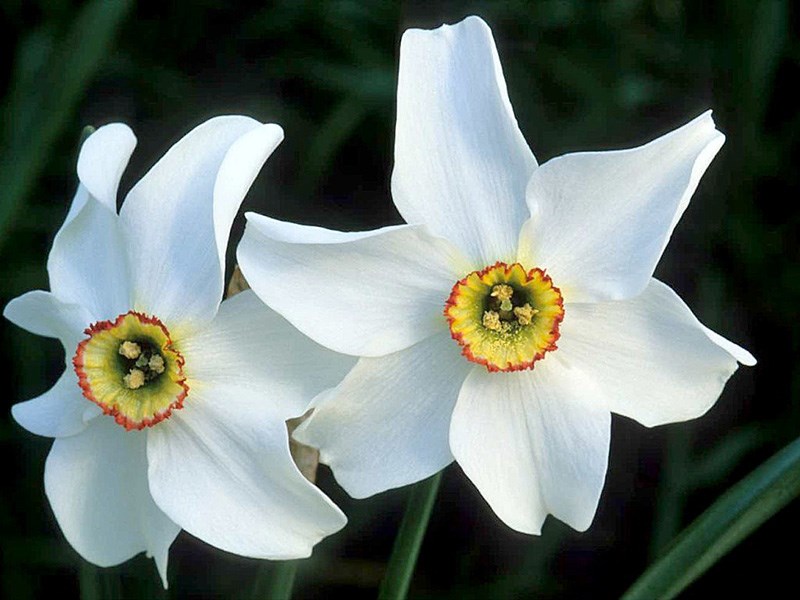I’ve always been rather fond of narcissus. I’ll never forget the afternoon I spent in Holland at a breeder’s field that was blooming with over 1500 narcissus varieties. It was an unbelievable opportunity to observe some old friends and to meet some new ones. It was also a chance to see how each variety handled cool, rainy and windy weather. With very little time, I was almost running through the field, notating varieties with outstanding colour, vigour and form, then comparing them to the old standbys I’ve known for so many years. Trying to meet and remember so many new faces in a few short hours is a very frustrating experience but I did learn quite a few valuable lessons.
Although narcissus will grow almost anywhere in the Northern Hemisphere, they prefer cooler rooting conditions and love a sandy, well-drained soil. One of the first things I did in the field was dig down into the soil to feel its texture. It was reclaimed sea land which had become a well-drained sandy loam. The narcissus roots were long, vigorous and extremely healthy. It’s under these conditions that they perennialize and multiply so well.
There was no question that the very large flowered varieties (and some of them were absolutely gigantic) were very showy but the wind and rain had taken their toll on them. Not only were these big guys shorter lived but they and many of the double ones, were also laying over. The mid-sized double and single varieties stood up very well and created, perhaps, the most colourful effect but as I expected the smaller sized varieties were the most prolific and outlasted everything else. It occurred to me that within the eleven generally recognized families or divisions of narcissus, there are three basic types that gardeners should use in three different locations.
The narcissus varieties bred for their extra large or unusual blossoms make wonderful additions to our gardens but they should be used as just that – as novelties. Varieties, like ‘Galactic Star’ with its soft yellow petals and almost white trumpet; ‘Tahiti’, an orange centred yellow; and the white and orange ‘Charisma’, are real garden beauties but they need a location where they have some protection from wind and rain. Plant them beside a windbreak or if possible, under an evergreen or other garden feature, like a birdbath, where they will find shelter. There are a number of exquisite novelties, like these, that deserve a special location in your garden. Some are more weather tolerant than others but most will require a little more care and shelter. Also, as a rule of thumb, they do not bloom as prolifically nor do they naturalize as well as mainstream narcissus.
The real frontline garden performers are the medium-sized and multi-flowered narcissus varieties. There are dozens and dozens of varieties that, with a little care, multiply and bloom year after year and stand up well under wet and windy spring conditions. The ‘cyclamineus’ varieties, like ‘February Gold’ and my favourite, ‘Tete-a-Tete’, are among the toughest and most weather tolerant. ‘Small cupped’ varieties, like ‘Barrett Browning’, are very prolific. The ‘poeticus’ variety of narcissus is one of the last to flower each spring and ‘Poeticus recurvus’ (Pheasant’s Eye), with its white petals and yellow, red-rimmed cup, is the largest.
Little narcissus that are cute as a button and sometimes just as small, are the ones that multiply well and last the longest. They too need a special location. From the tiniest little species, Narcissus bulbocodium and the amazing bunch-flowering ‘Golden Bells’ to the tiny but vigorous ‘jonquillas’, like ‘Minnow’ and ‘Quail’, there are many varieties of small narcissus that add pure charm to any garden. These varieties need to be placed in rock gardens or among compact azaleas and rhododendrons where they can be enjoyed as a contrast to the other small plants around them. Give them a little pocket somewhere in a well-drained sandy spot and they will delight you for years.
An unknown jewel and one of the earliest narcissus to bloom is ‘Rijnveld’s Early Sensation’. It blooms in late winter, about three weeks before anything else, when that early colour is so precious.
A great innovation has been a packaged collection of six varieties of yellow narcissus branded as ‘Yellow Brick Road”. This collection is blended to start blooming very early and continues to bloom very late for a continuous show of colour from six weeks to two months — a brilliant idea. And remember, they are deer resistant.



